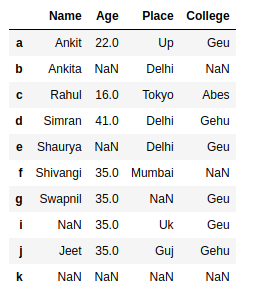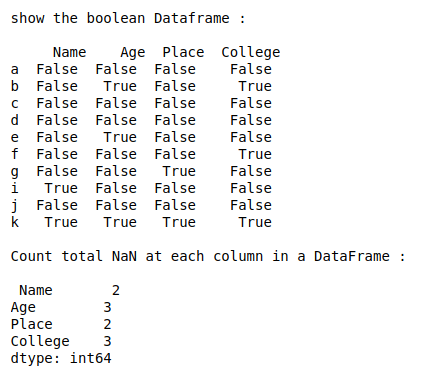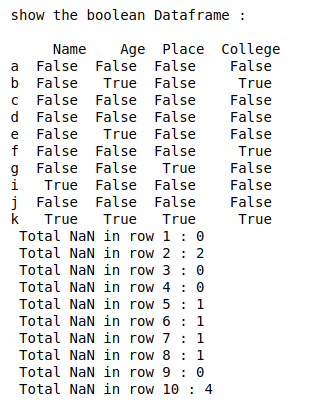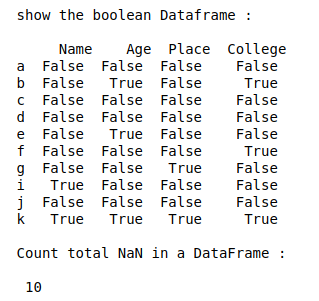计算Pandas数据框架中的NaN或缺失值
在这篇文章中,我们将看到如何使用数据框架的isnull()和sum()方法来计算Pandas数据框架中的NaN或缺失值。
Dataframe.isnull() 方法
Pandas isnull()函数检测给定对象中的缺失值。它返回一个布尔值大小相同的对象,表明这些值是否为NA。缺失的值被映射为True,非缺失的值被映射为False。
语法: DataFrame.isnull()
参数: None
返回类型:布尔值的数据帧,对NaN值为真,否则为假。
dataframe.sum() 方法
Pandas sum()函数返回所请求的轴的数值之和。如果输入的是索引轴,那么它将一列中的所有数值相加,并对所有列重复同样的操作,然后返回一个包含每一列中所有数值之和的序列。它还提供了在计算时跳过缺失值的支持。
语法: DataFrame.sum(axis=None, skipna=None, level=None, numeric_only=None, min_count=0, **kwargs)
参数:
- axis : {index (0), columns (1)}
- skipna : 计算结果时不包括NA/空值。
- level : 如果轴是一个多指标(分层),则沿某一层次计数,折叠成一个系列
- numeric_only : 只包括浮点、int、boolean列。如果没有,将尝试使用所有数据,然后只使用数字数据。未对系列实现。
- min_count : 执行该操作所需的有效值的数量。如果少于min_count的非NA值,结果将是NA。
返回:系列或数据框架的总和(如果指定级别)。
让我们来创建一个pandas数据框架。
# import numpy library as np
import numpy as np
# import pandas library as pd
import pandas as pd
# List of Tuples
students = [('Ankit', 22, 'Up', 'Geu'),
('Ankita', np.NaN, 'Delhi', np.NaN),
('Rahul', 16, 'Tokyo', 'Abes'),
('Simran', 41, 'Delhi', 'Gehu'),
('Shaurya', np.NaN, 'Delhi', 'Geu'),
('Shivangi', 35, 'Mumbai', np.NaN ),
('Swapnil', 35, np.NaN, 'Geu'),
(np.NaN, 35, 'Uk', 'Geu'),
('Jeet', 35, 'Guj', 'Gehu'),
(np.NaN, np.NaN, np.NaN, np.NaN)
]
# Create a DataFrame object from
# list of tuples with columns
# and indices.
details = pd.DataFrame(students, columns =['Name', 'Age',
'Place', 'College'],
index =['a', 'b', 'c', 'd', 'e',
'f', 'g', 'i', 'j', 'k'])
details
输出:

实例1 :计算DataFrame中每一列的NaN总数。
# import numpy library as np
import numpy as np
# import pandas library as pd
import pandas as pd
# List of Tuples
students = [('Ankit', 22, 'Up', 'Geu'),
('Ankita', np.NaN, 'Delhi', np.NaN),
('Rahul', 16, 'Tokyo', 'Abes'),
('Simran', 41, 'Delhi', 'Gehu'),
('Shaurya', np.NaN, 'Delhi', 'Geu'),
('Shivangi', 35, 'Mumbai', np.NaN ),
('Swapnil', 35, np.NaN, 'Geu'),
(np.NaN, 35, 'Uk', 'Geu'),
('Jeet', 35, 'Guj', 'Gehu'),
(np.NaN, np.NaN, np.NaN, np.NaN)
]
# Create a DataFrame object from list of tuples
# with columns and indices.
details = pd.DataFrame(students, columns =['Name', 'Age',
'Place', 'College'],
index =['a', 'b', 'c', 'd', 'e',
'f', 'g', 'i', 'j', 'k'])
# show the boolean dataframe
print(" \nshow the boolean Dataframe : \n\n", details.isnull())
# Count total NaN at each column in a DataFrame
print(" \nCount total NaN at each column in a DataFrame : \n\n",
details.isnull().sum())
输出:

示例2:计算数据框架中每一行的NaN总数。
# import numpy library as np
import numpy as np
# import pandas library as pd
import pandas as pd
# List of Tuples
students = [('Ankit', 22, 'Up', 'Geu'),
('Ankita', np.NaN, 'Delhi', np.NaN),
('Rahul', 16, 'Tokyo', 'Abes'),
('Simran', 41, 'Delhi', 'Gehu'),
('Shaurya', np.NaN, 'Delhi', 'Geu'),
('Shivangi', 35, 'Mumbai', np.NaN ),
('Swapnil', 35, np.NaN, 'Geu'),
(np.NaN, 35, 'Uk', 'Geu'),
('Jeet', 35, 'Guj', 'Gehu'),
(np.NaN, np.NaN, np.NaN, np.NaN)
]
# Create a DataFrame object from
# list of tuples with columns
# and indices.
details = pd.DataFrame(students, columns =['Name', 'Age',
'Place', 'College'],
index =['a', 'b', 'c', 'd', 'e',
'f', 'g', 'i', 'j', 'k'])
# show the boolean dataframe
print(" \nshow the boolean Dataframe : \n\n", details.isnull())
# index attribute of a dataframe
# gives index list
# Count total NaN at each row in a DataFrame
for i in range(len(details.index)) :
print(" Total NaN in row", i + 1, ":",
details.iloc[i].isnull().sum())
输出:

实例3:计算数据框架中的NaN总数。
# import numpy library as np
import numpy as np
# import pandas library as pd
import pandas as pd
# List of Tuples
students = [('Ankit', 22, 'Up', 'Geu'),
('Ankita', np.NaN, 'Delhi', np.NaN),
('Rahul', 16, 'Tokyo', 'Abes'),
('Simran', 41, 'Delhi', 'Gehu'),
('Shaurya', np.NaN, 'Delhi', 'Geu'),
('Shivangi', 35, 'Mumbai', np.NaN ),
('Swapnil', 35, np.NaN, 'Geu'),
(np.NaN, 35, 'Uk', 'Geu'),
('Jeet', 35, 'Guj', 'Gehu'),
(np.NaN, np.NaN, np.NaN, np.NaN)
]
# Create a DataFrame object from
# list of tuples with columns
# and indices.
details = pd.DataFrame(students, columns =['Name', 'Age',
'Place', 'College'],
index =['a', 'b', 'c', 'd', 'e',
'f', 'g', 'i', 'j', 'k'])
# show the boolean dataframe
print(" \nshow the boolean Dataframe : \n\n", details.isnull())
# Count total NaN in a DataFrame
print(" \nCount total NaN in a DataFrame : \n\n",
details.isnull().sum().sum())
输出:

 极客教程
极客教程